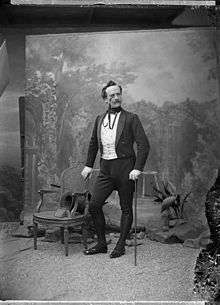Caran d'Ache
| Caran d'Ache | |
|---|---|
 Photographed 1890 by Atelier Nadar | |
| Born |
Emmanuel Poiré November 6, 1858 Moscow, Russian Empire |
| Died |
February 26, 1909 (aged 50) Paris, France |
| Nationality | French |
Caran d'Ache was the pseudonym of the 19th century French satirist and political cartoonist Emmanuel Poiré (November 6, 1858 – February 26, 1909).[1] "Caran d'Ache" comes from the Russian word karandash (карандаш), meaning pencil, which in turn comes from the Turkish words kara taş, meaning black stone. While his first work glorified the Napoleonic era, he went on to create "stories without words" and as a contributor to newspapers such as the Lundi du Figaro, he is sometimes hailed as one of the precursors of comic strips. The Swiss art products company Caran d'Ache is named after him.[2]
Biography

Born in Moscow, 6 November 1858, he was the grandson of an Officer-Grenadier in Napoleon's Grande Armée who, wounded during the Battle of Borodino, had stayed behind in Russia.[3] After his grandfather's death he was adopted by a Polish family whose daughter he later married.
In 1877 Caran d'Ache emigrated to France where he took French citizenship and joined the Army[3] for five years where he was assigned to design uniforms for the ministry of war and where he also contributed to their journal, La Vie militaire, with satirical illustrations, among them some caricatures of the German army.[1]
He died in Paris on 26 February 1909 at the age of 50.
Works
- 1880: His first drawings of military caricatures were published in La Chronique Parisienne.[4]
- 1892: Caran d'Ache published Carnet de Chèques ("Checkbook") on the Panama Canal Affair.
- 1895: He started publishing editorial cartoons (every Monday) in the daily Le Figaro, and soon thereafter for the popular weekly Le Rire.
- 1898: Émile Zola published J'Accuse, which brought the Dreyfus Affair into the spotlight.
With fellow cartoonist Forain, he founded Psst... !, a magazine that lasted 85 numbers entirely composed of cartoons by Caran d'Ache and Forain, caricaturing the society and its scandals, showing violent antisemitism and also defending the French army's honor.
Sources
- 1 2
 Chisholm, Hugh, ed. (1911). "Caran d'Ache". Encyclopædia Britannica (11th ed.). Cambridge University Press.
Chisholm, Hugh, ed. (1911). "Caran d'Ache". Encyclopædia Britannica (11th ed.). Cambridge University Press. - ↑ Caran d’Ache and the story of the black stone Archived October 29, 2011, at the Wayback Machine.
- 1 2 Graphic Witness. "Le Rire".
- ↑ Lambiek Comiclopedia. "Caran d'Ache".
External links
| Wikimedia Commons has media related to Caran d'Ache. |
| Wikisource has the text of the 1911 Encyclopædia Britannica article Caran d'Ache. |
- Caran d'Ache biography on Lambiek Comiclopedia